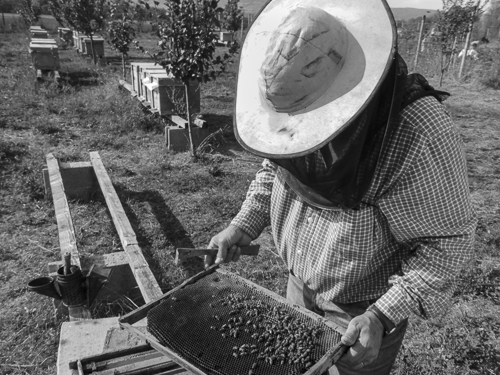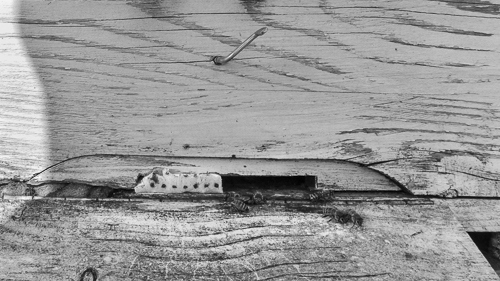Driving past the village of Zoltán and passing a muddy road, we arrived at the property of Gergely László and his wife. Inside a fence, they had beehives, an orchard, a pond, a chicken coop and a small house. The property was 3/2 hectares and 5-6 dogs were protecting it against bears.
Upon entering the property, we were met by all the dogs, next we were invited to join Mr Gergely to his 8-sided pavilion, which was located next to a pond being replenished by water falling down from a wooden chute. Herbs were hanging from the ceiling and they would be turned into herbal teas when time was due.
While my guide was speaking with Mr Gergely, I noticed a slingshot lying on the table. It was used for scaring away frogs and toads, which were eating fish in the pond.
The Gergely couple bought the land, which was a vegetable garden in communist times, 4 years ago and they had to pay for a survey of 20 hectares to get the property registered. In fact, they paid more for the survey than for the land. The water flowing into the pond came from two wells located 600 m from the pond. Both of them contain large pieces of concrete and they are camouflaged in order to avoid sabotage.
Many years ago, a friend tried to convince him to be a beekeeper, but he resisted for several years. Next, he got one beehive as a gift and found that he liked beekeeping. Then, his friend made him receive 27 more beehives. He collaborated with him and learnt from him and other beekeepers, but now his friend is ill.
The first 3 years were very difficult and he had to ask for help often, but he gradually learnt how to do it. After many years of beekeeping, 6 of them as a professional, he can easily survive 30-50 bee stings, but he has to protect his face.
The beekeeping is family-driven: husband, wife, and 2 daughters. He does most of the work, but everyone extracts honey.
Originally both husband and wife were forest engineers with their own timber business, but it didn’t pay off, being heavily influenced by the price of timber. Moreover, an Austrian timber company built a big sawmill nearby and out-competed small producers.
This is the first year they only sell honey, while before they were selling timber and honey.
After a while, Mr Gergely let us see him inspect his beehives. He only used a hood with netting to protect his face, while we had protection for our upper bodies. While he was showing his beehives, opening some of them, he went on talking about beekeeping.
Mr Gergely has 100 beehives here and 130 close to forests, 30-50 km from here and they would be brought home soon. The mobile bees are released near or on meadows from July to autumn and they can pollinate any type of flower. He needs one person to help him load and unload the beehives and he has to go twice to fetch the beehives because there is too little space in his car.
There were a lot of empty racks, but they would be filled with the mobile beehives.
The season starts in Feb-March, April when the bees start collecting pollen, mainly from flowers, depending on the vegetation in the area. This year, they had been collecting a lot of pollen from linden, but not so much from acacia and rapeseed.
2019 was a bad year for beekeepers in this area because of a cold, rainy spring, but the rest of the year had been good so far.
He sells minimum 2000 kg and maximum 7000 kg of honey a year. He always wants to ensure quality. His golden rule is to apply no additives and no sugar.
He says that beekeeping is not an exact science, you need experience and attention to detail and you have to accommodate all situations.
He has mounted a scale below some random beehives in order to measure how much honey the bees are producing, while all other weights are estimates. There may be more, the same or less than the ones which are weighed.
Experienced beekeepers have 200 beehives, 100 stationary and 100 mobile. After some time, they have to make the mobile bees stronger by means of the stationary ones.
Pesticides are a problem and the beekeepers want the government to enforce a ban on pesticides for rapeseed when the flowers are blooming, but they aren’t listened to.
He has a dilemma regarding the consistency of the honey: in about 1 of 40 jars, the honey crystallises , while the others stay liquid and he doesn’t know why. Those who want to know more about honey crystallisation can watch this video.
He feeds sugar and water to the bees in winter, but they are also eating honey in order to survive.
Varroa causes problems for the bees and he treats them with medicine. If it doesn’t work, they make herbal teas for the bees.
The bees are stealing from each other, strong bees from weak ones. He’s trying to minimise the problem by using a small opening in the weak beehives.
Honeydew is a valuable type of honey, but he hasn’t been able to make it.
1 kg jars of honey are very popular and they are selling all of them.
In case of a cold February and a mild March, the bees stay with their young rather than going to the outer frames with honey, keeping the young warm. That is, the grown-up bees prefer to starve to death in order to protect their young.
We also walked around the orchard and the kitchen garden. They were growing fruit trees like apple, plum, pear and quince together with raspberry, mulberry, tomatoes and others. Besides, they are growing rapeseed, acacia, lime and sunflower.
Mr Gergely’s wife fed the poultry and the rabbits during our visit.
He’s fed up with city life, he wants to be self-sufficient and live here and get water from a well. However, he has no mains electricity. The area, being surrounded by fields, is quiet and peaceful and there are no neighbours nearby.
They have a house in the village and they want to sell it. Regarding electricity, they can get get mains or use solar power with batteries, which must be changed every 6-7 years. Mains electricity is more convenient, but it has a high initial investment.
Their eldest daughter studies to be a vet. She gets offers to work abroad, but she wants to come home and help her father. The other daughter goes to high school.
Mr Gergely kindly gave me 1 kg jar of honey.









